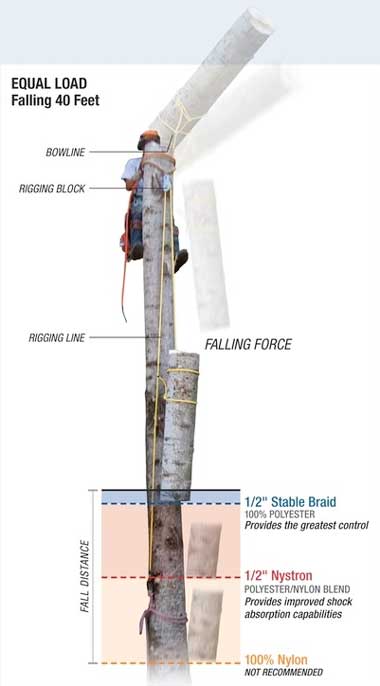Most arborists would agree: tree rigging is a complicated business.
Up until recently rigging lines available in New Zealand were almost all low-stretch, double braid polyesters, either Samson Stable Braid and Yale Double Esterlon or 12-strand Samson TenexTEC and Yale Yalex.
A generation of kiwi arborists have been trained on the low-stretch, loading properties of these ropes.
Now both Samson and Yale have introduced stronger, lighter polyester sheath, nylon core double braids capable of higher dynamic loads (Samson Nystron and Yale Polydyne).
The logic behind these new ropes is both economical and practical.
Nylon is a relatively inexpensive component. This helps to make the nylon core rigging line cheaper to manufacture per meter than all-polyester equivalents.
And the high elongation properties of nylon, when sheathed in abrasion resistant polyester, helps reduce peak loading. In theory, increased elongation puts less stress on the rope, the rigging hardware and the tree in a rigging configuration.
But the increased elongation of Samson Nystron and Yale Polydyne (up to 4 times that of polyester double braids) also reduces the amount of control you have over the peak-load positioning of the rigged timber - see image below.
Accurately calculating the distance of elongation or travel relative to the weight of the load would test any mathematician. As an example, the fact that rope stretch adds distance to the fall was not even factored into arborist rigging software like Rigging 1.0.
Consequently, nylon core rigging lines should ideally only be used when you are rigging in open spaces, where there is little chance of hitting a valuable object (or person).
In some ways having a limited range of rigging lines available was a far simpler proposition.
With a well trained, experienced groundie one (or two) rigging lines would suffice. Now, you may end up with multiple rigging lines designed for very specific rigging applications - they work perfectly for their designed purpose but are unsuitable as general, utility rigging lines.
Let's hope there are no knowledge 'gaps' in tree rigging education!

